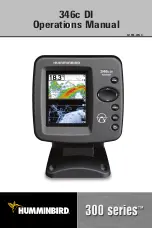
28
2. The epoxy consists of the epoxy itself and a hardener. Remove the
two compounds from the package and place them on the paper plate.
Thoroughly stir the two compounds together until the mixture has a
uniform color and consistency. Do not mix too fast or bubbles will
form in the epoxy. After mixing, you have 20 minutes to complete the
installation before the epoxy becomes unworkable.
Spread a thin layer of epoxy (about 1/16" or 1.5 mm thick) on the face
of the transducer as shown in the previous figure.
Make sure there
are no air pockets in the epoxy layer!
Then, apply the remaining ep-
oxy to the sanded area on the hull.
3. Press the transducer into the epoxy, twisting and turning it to force
any air bubbles out from under the transducer face. Stop pressing
when you bottom out on the hull. When you're finished, the face of
the transducer should be parallel with the hull, with a minimum
amount of epoxy between the hull and transducer.
4. Apply a weight, such as a brick, to hold the transducer in place while
the epoxy cures. Be careful not to bump the transducer while the ep-
oxy is wet. Leave the weight in place for a minimum of three hours.
Allow the epoxy to cure for 24 hours before moving the boat.
5. After the epoxy has cured, route the cable to the sonar unit and it's
ready to use.
Speed/Temperature Sensors
These units can accept additional temperature sensors which can be
used to monitor the temperature of surface water, a live well or some
other location. The SeaCharter 480DF can accept as many as three
temperature sensors, and the FishElite 480 can accept as many as two.
These units can also accept an optional speed sensor for showing speed
and distance traveled.
However, the FishElite 480 can only use one accessory at a time, so if you
would like to use a speed sensor and a second temperature sensor at the
same time, you will need a combination device.
NOTE:
These units are packed with a transducer containing a built-in temp
sensor. The SeaCharter 480DF package also includes a speed sensor.
If you have a FishElite 480 and want a speed sensor or additional
temp sensor, see the Accessory Ordering Information in the back of
this manual.
Summary of Contents for FishElite 480
Page 20: ...12 Notes ...
Page 100: ...92 Notes ...
Page 144: ...136 Notes ...
Page 194: ...186 Notes ...
Page 198: ...190 Notes ...

































